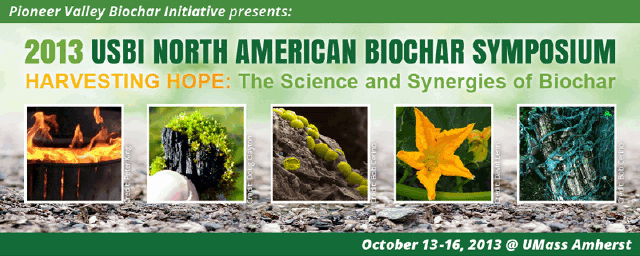Feedstocks & Production
Large Scale Production
Streaming Media
Brian Von Herzen presentation
F&P Tom Grissolm.pdf (946 kB)
Tom Grissolm presentation
F&P Gardner.pdf (2473 kB)
Tom Gardner presentation
F&P Amaron Energy.pdf (6648 kB)
Eric Eddings presentation
Location
CC 163
Start Date
16-10-2013 10:00 AM
End Date
16-10-2013 11:20 AM
Session Description
Special Q&A video: http://youtu.be/NGcd-34La8o
Biochar production, processing, sales and research using a BiG char rotary hearth kiln: Josiah Hunt
http://www.youtube.com/watch?v=TNruR6brsn4
A photographic journey through the Hawaiian Mahogany Inc. Biochar Pilot Program’s operations. From feedstock to farm, with lots of twists and turns in between. The operation involves harvesting biomass trees from the plantation where the facility is located, chipping them, drying them, and charring them. Also included is sharing the heat with the co-located grass drying operation, post-processes of the biochar materials before sale, and marketing efforts including research and education.
Extending the Frontiers of High-Moisture Feedstocks for Biochar Reactors: Brian Von Herzen, The Climate Foundation
http://www.youtube.com/watch?v=kPDPKuVkiBc
The Climate Foundation and Stanford University developed a prototype biochar reactor for high-moisture content materials such as human solid waste (HSW). The reactor architecture is intended to sanitize waste from hundreds of people per day, and to be deployed in developing nations and operate with neither external electric power nor external water supply. A further goal is to produce biochar for use in agriculture.
Here we report on a larger reactor that Climate Foundation is developing for field trials in Nairobi, Kenya in early 2014. Reactor construction and operation will be discussed, along with demonstration results. We expect this scaled biochar reactor to produce electricity and process heat as well as biochar.
Portable Rotary Kilns for Farmers & Foresters: Ralph Coates, Amaron Energy (presented by Eric Eddings of Amaron Energy)
http://www.youtube.com/watch?v=jv-yweB6Suo
Amaron Energy has developed a novel biomass pyrolysis technology based on a rotary reactor concept. Many different feedstocks have been tested, and both torrefaction and pyrolysis operating modes are feasible. This mobile unit can process P-J wood at remote locations near where it is harvested, and fits inside a 20 ft. long shipping container mounted on a trailer. Bio-oil yields ranged from47% to 55%, bio-char yields ranged from 25% to 32% and a typical bio-char carbon content was 73%.
Amaron is currently working on scaling up to a larger commercial size unit using a 20-inch diameter rotary reactor that will have the capacity to process 10 tons of biomass per day.
Harnessing the Power of Biochar for Clean Energy & Healthy Soils: Tom Grissom, International Tech Corp
Carbon neutral power generation is a key path forward in the supply of biochar. Pyrolysis, in the proper form, can use waste feed-stocks and convert them into energy. The Thermal Recovery Unit(TRU) is heated by natural gas, biodiesel or other fuels. For every BTU of fuel put into the system, we can get 8 BTUs out, with a feedstock of woody biomass at or below 15% moisture content. If the system is heated by natural gas, we can extend the life of that fossil fuel by 800 percent, making it an ideal conservation technology. The output of the TRU has no particulate and the harmful greenhouse gasses are destroyed by a thermal oxidizer. The TRU can efficiently recover the heat produced from the thermal degradation of the syngas. All of the solids are collected as biochar, a sequestered form of stable carbon. The TRU makes a very nice biochar, usually in the 85% carbon range. Temperature and residence time, in the system, can be controlled by a touch-screen control panel. This continuous pyrolysis system can process between 1000 and 6000 lbs an hour of feed-stock. This will provide biochar producers with a proven, commercially viable option.
Large Scale Production
CC 163
Special Q&A video: http://youtu.be/NGcd-34La8o
Biochar production, processing, sales and research using a BiG char rotary hearth kiln: Josiah Hunt
http://www.youtube.com/watch?v=TNruR6brsn4
A photographic journey through the Hawaiian Mahogany Inc. Biochar Pilot Program’s operations. From feedstock to farm, with lots of twists and turns in between. The operation involves harvesting biomass trees from the plantation where the facility is located, chipping them, drying them, and charring them. Also included is sharing the heat with the co-located grass drying operation, post-processes of the biochar materials before sale, and marketing efforts including research and education.
Extending the Frontiers of High-Moisture Feedstocks for Biochar Reactors: Brian Von Herzen, The Climate Foundation
http://www.youtube.com/watch?v=kPDPKuVkiBc
The Climate Foundation and Stanford University developed a prototype biochar reactor for high-moisture content materials such as human solid waste (HSW). The reactor architecture is intended to sanitize waste from hundreds of people per day, and to be deployed in developing nations and operate with neither external electric power nor external water supply. A further goal is to produce biochar for use in agriculture.
Here we report on a larger reactor that Climate Foundation is developing for field trials in Nairobi, Kenya in early 2014. Reactor construction and operation will be discussed, along with demonstration results. We expect this scaled biochar reactor to produce electricity and process heat as well as biochar.
Portable Rotary Kilns for Farmers & Foresters: Ralph Coates, Amaron Energy (presented by Eric Eddings of Amaron Energy)
http://www.youtube.com/watch?v=jv-yweB6Suo
Amaron Energy has developed a novel biomass pyrolysis technology based on a rotary reactor concept. Many different feedstocks have been tested, and both torrefaction and pyrolysis operating modes are feasible. This mobile unit can process P-J wood at remote locations near where it is harvested, and fits inside a 20 ft. long shipping container mounted on a trailer. Bio-oil yields ranged from47% to 55%, bio-char yields ranged from 25% to 32% and a typical bio-char carbon content was 73%.
Amaron is currently working on scaling up to a larger commercial size unit using a 20-inch diameter rotary reactor that will have the capacity to process 10 tons of biomass per day.
Harnessing the Power of Biochar for Clean Energy & Healthy Soils: Tom Grissom, International Tech Corp
Carbon neutral power generation is a key path forward in the supply of biochar. Pyrolysis, in the proper form, can use waste feed-stocks and convert them into energy. The Thermal Recovery Unit(TRU) is heated by natural gas, biodiesel or other fuels. For every BTU of fuel put into the system, we can get 8 BTUs out, with a feedstock of woody biomass at or below 15% moisture content. If the system is heated by natural gas, we can extend the life of that fossil fuel by 800 percent, making it an ideal conservation technology. The output of the TRU has no particulate and the harmful greenhouse gasses are destroyed by a thermal oxidizer. The TRU can efficiently recover the heat produced from the thermal degradation of the syngas. All of the solids are collected as biochar, a sequestered form of stable carbon. The TRU makes a very nice biochar, usually in the 85% carbon range. Temperature and residence time, in the system, can be controlled by a touch-screen control panel. This continuous pyrolysis system can process between 1000 and 6000 lbs an hour of feed-stock. This will provide biochar producers with a proven, commercially viable option.



Bio and Photo
Josiah Hunt
Eric Eddings
Tom Grissom